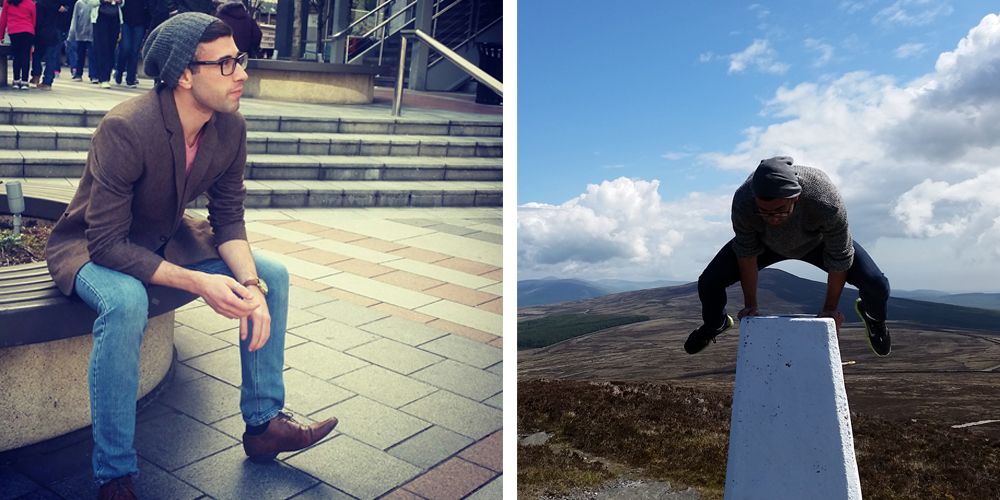PHD CANDIDATE MOE WEHBE ON FINDING NEW STANDARDS OF CARE FOR GLIOBLASTOMA MULTIFORME, THE IMPORTANCE OF MENTORSHIP, AND THE BEST ADVICE HE RECEIVED ON APPLYING TO GRAD SCHOOL
You came to UBC from the University of Ottawa, where you completed a BSc (with honours) in biopharmaceutical science, specializing in medicinal chemistry. What brought you here?
MW: While I was finishing my honours project with Dr. Maxim Berezovski, which was to devise a method to purify an oncolytic virus (vesicular stomatitis virus) using aptamers, I took a course that was co-taught by Dr. Alain Musende. Dr. Musende is a UBC alumnus and a student of Dr. Marcel Bally, from the BC Cancer Agency. At that point, I hadn't considered graduate school anywhere, let alone on the other side of the country! However, Dr. Musende and I connected after class, and he suggested that I contact Dr. Bally to discuss my research interests and possible graduate training.
I received some sound advice from one of my inorganic chemistry professors on the topic of graduate school. He said, "Pick the supervisor, not the project." He meant that while your research project may evolve over time, your relationship with your supervisor will be ongoing. After speaking with Dr. Bally, it was an easy decision.
Your PhD research area is in lipid nanoparticles for the treatment of Glioblastoma Multiforme (GBM). What inspired you to pursue this area of research?
MW: Glioblastoma Multiforme is the most common and aggressive of all primary central nervous system tumours. It's very difficult to treat as it is an infiltrative disease, and is often asymptomatic until it reaches sizes large enough to cause an increase in intracranial pressure. The standard of care for GBM has not changed significantly in decades.
Most cancers are treated through combination chemotherapy. GBM can't be treated this way because most drugs do not cross the blood brain barrier. The use of lipid nanoparticles is something our lab specializes in, and so we are applying this technology to the treatment of GBM using a variety of drugs. All the formulations I've prepared are tested in a GBM cell line to see if they are efficacious.

What approach are you taking to your research? What's your primary goal?
MW: I started my work in the lab by making a list of chemotherapeutics that had a propensity to cross the blood brain barrier. We reasoned that if we could extend the circulation lifetime of these agents, there would be a good chance that that would also increase the amount of drug that was able to reach the brain.
Since then we have expanded to include the use of other drugs that are proposed to have anti-cancer activity in GBM. One such example is Disulfiram, a drug typically used to treat alcoholism.
You work alongside Dr. Marcel Bally at the BC Cancer Agency, and are co-supervised by Dr. Helen Burt from UBC Faculty of Pharmaceutical Sciences. How has their mentorship benefitted you, both personally and professionally?
MW: Dr. Helen Burt is very supportive of my research and directs me in the administrative aspects of being a graduate student. Dr. Burt ensures I get things done on time so that I can eventually graduate!
Working with Dr. Marcel Bally has been an exceptional experience. He is an incredibly supportive and patient mentor who has never told me that I can't try a new idea or drug – a fact for which I'm truly thankful. He provides feedback when needed, but he also allows me to work independently and learn from my mistakes. Dr. Bally has shaped how I approach research problems. He probably doesn't realize just how much I appreciate his mentorship. Thanks Marcel!
How do you feel your experiences at UBC Pharm Sci are preparing you to achieve your goal of creating a combination product to address the treatment needs of GBM?
MW: I transferred to UBC Pharm Sci from a pathology program. It was thanks to the support of Dr. Bally and Dr. Wayne Riggs that I made this decision. Dr. Riggs has mentored me in pharmacokinetic research, and although he is retired he is still only an email away. Pharmacokinetics is a hugely important aspect of drug development and the courses available at UBC Pharm Sci have helped prepare me to approach my own research problems. When it comes to creating combination products, the pharmacokinetics of both drugs need to be considered. Having a strong understanding of pharmacokinetic principles has made the process of drug development easier for me.
Dr. Abby Collier and Dr. Riggs have also allowed me to guest lecture, which has been a challenging and rewarding experience.
What do you enjoy doing in your spare time?
MW: I spend most of my spare time outdoors, hiking, running, playing basketball or volleyball. I'm also learning how to cook and so far I haven't started any large fires!
LEARN MORE ABOUT THE UBC PHD IN PHARMACEUTICAL SCIENCES
Image Credits: (Header) Ivan Yastrebov, UBC Pharm Sci. All other images thanks to Moe Wehbe.
About this series
Graduate Student Spotlight is an ongoing interview series designed to highlight our exceptional PhD and MSc candidates and their work, achievements, and experiences at UBC Pharm Sci.
